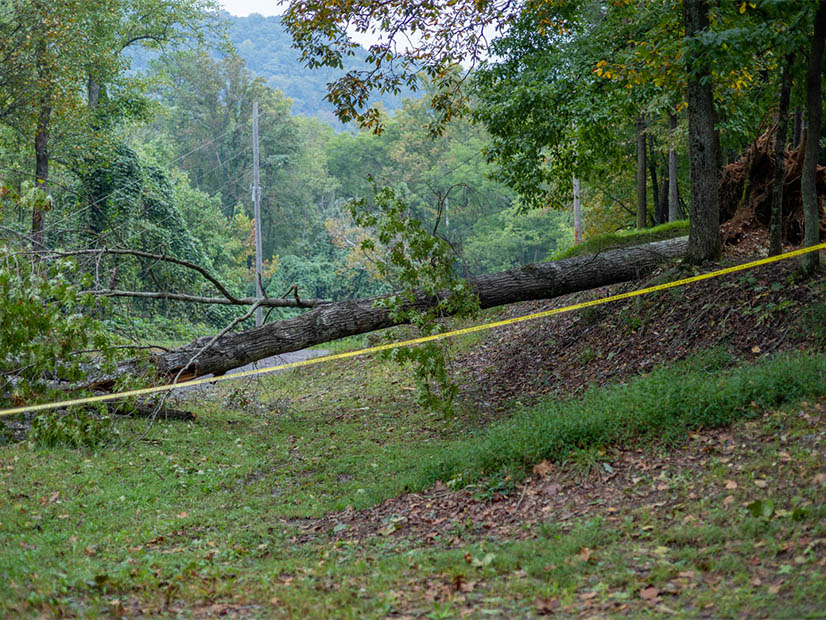
The utility industry continues to repair downed power lines and other infrastructure affected by Hurricane Helene. Much of the remaining work is on co-ops’ systems, according to the National Rural Electric Cooperative Association.
“Electric cooperatives serve the most remote, hardest to serve areas in the country, and so while this disaster affected all utilities and customers in many different utility locations, the consumers of electric cooperatives are in areas that are more remote, more rugged, more difficult to restore,” NRECA CEO Jim Matheson said Oct. 1.
The storm knocked out power to about 6 million customers across 10 states, of whom cooperatives serve 1.25 million, he added. As of Tuesday afternoon, cooperatives still had about 500,000 customers without power. Most of those should get their lights back by the end of the week.
“This could have a long tail to it, in terms of when you reach everyone getting power back on,” Matheson said. “This could take days. This could take weeks, in some cases, because of the location and the amount of damage and what it’s going to take to essentially not just hook something up that happened to break apart, but really rebuild from the ground up, some of these components of the electric system.”
Tri-County Electric Co-op of Florida serves some of the area first affected by the storm. At its peak, 99% of its meters were offline on a system that averages six meters per mile of wire, largely residential and agricultural customers, said CEO Julius Hackett.
“We’re dealing with 700-plus broken poles,” he added. “We still have 12,300 meters out. But we have 2,000 line-workers and vegetation management professionals on the scene.”
The restoration has been progressing well, but it is slower than the co-op would prefer due to the Category 4 hurricane winds that significantly damaged its system, said Hackett.
The storm knocked out an additional 350,000 customers at co-ops in Georgia, said Dennis Chastain, CEO of the Georgia Electric Membership Corp., which represents all the co-ops in the state.
“I’ve been in this business for 38 years, and I’ve never seen anything like it,” Chastain said. “I’ve got one of my vice presidents who’s been here 50 years, and he’s an ex-lineman, and he’s never seen anything like it either.”
Electric Cooperatives of South Carolina CEO Mike Couick agreed Helene’s impact on the system was unlike any storm his members have dealt with in decades.
“It’s not a restoration, it’s a rebuild,” he added. “Every one of my co-ops in this state were affected. It affected all 46 counties.”
Particularly hard hit was the Blue Ridge Electric Co-op, named for the mountain range that runs through its territory, where line workers must repair 7,300 miles of wires, including lines that run straight up mountainsides.
“When we talk about putting a new power pole in because one’s broken, we generally say it takes four men up to four hours to put in one pole,” Couick said. “I’m not sure that’s the right number at Blue Ridge. Think about going up the side of a mountain, putting in a new pole, and you’re going to drill through a rock and sink it. You may not have access to roads to get the pole there, and then you gotta carry it there.”
Blue Ridge thinks it has about 600 broken poles to fix, but it cannot be sure this early in the process as accessing some of the more remote parts of its system is difficult, he added.
Western North Carolina was among the hardest hit regions by Helene where the issue is not just fixing the grid but washed-out roads and homes that were swept away by the storm and related flooding, said EnergyUnited CEO Thomas Golden.
“Mudslides, flooding and downed trees have made entire communities inaccessible,” he added. “Crews can’t even reach some members because roads have been washed away or blocked by debris. And when they do get through, they’re not finding a few downed lines, they’re finding entire spans of wire pulled down by trees, poles snapped in half and infrastructure washed away by floodwaters.”
So far, cooperatives have found enough material to make the repairs, but NRECA’s Matheson said supply issues must be monitored due to the widespread damage across all kinds of utility ownership.
“We need to keep an eye on this, because we very well could have supply chain challenges emerge in the next few days that we haven’t seen,” Matheson said. “The good news is, so far, I haven’t heard of any significant supply chain challenge.”
Two of the hardest-hit investor-owned utilities provided updates Oct. 1 on their progress repairing Helene’s damage.
Georgia Power said it had restored service to 1 million customers, which is about 80% of those affected, but additional 278,000 remained without service. The utility said Helene damaged or destroyed 8,000 poles, 1,000 miles of wire, 1,500 transformers and led to 3,200 trees falling on lines.
Duke Energy Carolinas reported it had restored power to 566,000 customers in South Carolina and 1 million in North Carolina with 363,000 and 284,000 remaining without service, respectively. Power restoration may take longer in areas that are inaccessible due to hurricane damage to other infrastructure.
“We’ve never seen such widespread devastation and destruction as we’re seeing in this region,” Jason Hollifield, Duke Energy storm director for the Carolinas, said in a statement.
